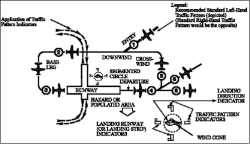 Did you ever wonder exactly what a tower controller means when he or she says “Make Right Traffic?” It means, fly to a position where you can enter the traffic pattern on the 45, then turn to downwind and fly the traffic pattern. It doesn’t mean to enter on the downwind, or any other way to join a pattern. This is just one of many tidbits I cover in last week's Aviation News Talk podcast, in which I talk about flying the traffic pattern, and talk in detail about flying a Cessna 172 in the traffic pattern. We also talk about when you're most likely to get cut out by another aircraft in the pattern and what you can do about it, and about doing a forward slip in a Cessna 172 and use of flaps during crosswind landings, among other things.
Did you ever wonder exactly what a tower controller means when he or she says “Make Right Traffic?” It means, fly to a position where you can enter the traffic pattern on the 45, then turn to downwind and fly the traffic pattern. It doesn’t mean to enter on the downwind, or any other way to join a pattern. This is just one of many tidbits I cover in last week's Aviation News Talk podcast, in which I talk about flying the traffic pattern, and talk in detail about flying a Cessna 172 in the traffic pattern. We also talk about when you're most likely to get cut out by another aircraft in the pattern and what you can do about it, and about doing a forward slip in a Cessna 172 and use of flaps during crosswind landings, among other things.
We also talk about a recent SR22 fatal crash in Northern California in which the pilot apparently pulled the parachute at too low an altitude, most likely making things worse in the process. The absolute minimum altitude to pull is 400 feet, 600 feet on the new G5 and G6 models, yet some pilots still seem to believe that pulling at lower altitudes could slow the plane; they are dead wrong and we talk about why.
We also give an update on the Air Canada 759 near miss at San Francisco. In the past week, I was quoted in two articles in the San Jose Mercury News and appeared on local television news twice to discuss the incident. I ran calculations that show that at the Air Canada's lowest point of descent, it was just 26’ above the top of the airliner in front of it on the taxiway, before it achieved a positive rate of climb. In the podcast, I talk about "confirmation bias" and how that may have contributed to the pilot believing he was correctly lined up, even after asking about "lights on the runway."
You can find and download this and all of my podcast episodes on Apple iTunes, or listen to it at Aviationnewstalk.com, where you'll also find links in the right column for Android phones and other podcast players.